
Gunda is a genus of moths of the family Bombycidae. The genus was erected by Francis Walker in 1862. It is primarily an Oriental genus, found in India, China and South-east Asia.
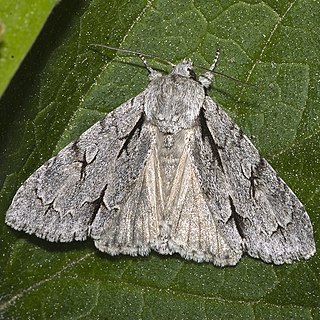
Acronicta is a genus of noctuid moths containing about 150 species distributed mainly in the temperate Holarctic, with some in adjacent subtropical regions. The genus was erected by Carl Linnaeus in his 1758 10th edition of Systema Naturae. Caterpillars of most Acronicta species are unmistakable, with brightly colored hairy spikes, and often feed quite visibly on common foliate trees. The hairy spikes may contain poison, which cause itchy, painful, swollen rash in humans on contact. The larva of the smeared dagger moth is unusually hairy even for this genus. Acronicta species are generally known as dagger moths, as most have one or more black dagger-shaped markings on their forewing uppersides. But some species have a conspicuous dark ring marking instead.

Cyana is a genus of moths in the family Erebidae. Species are well distributed in Africa, Madagascar, China, India, Sri Lanka, Myanmar, Sumatra, Java and Borneo. The genus was erected by Francis Walker in 1854.

Orthonama obstipata, the gem, is a moth of the family Geometridae. The species was first described by Johan Christian Fabricius in 1794. It is a cosmopolitan species. In continental Europe though in the northeast, its range does not significantly extend beyond the Baltic region and it is absent from northern Russia. This well-flying species is prone to vagrancy and able to cross considerable distances of the open sea; it can thus be regularly found on the British Isles and even on Iceland.
Lambula is a genus of moths in the family Erebidae. The genus was erected by Francis Walker in 1866.
Mantala is a monotypic moth genus in the subfamily Arctiinae. Its single species, Mantala tineoides, is found on Borneo. Both the genus and the species were first described by Francis Walker in 1862. The habitat consists of lowland and lower montane forests.

Teulisna is a genus of moths in the family Erebidae. The genus was erected by Francis Walker in 1862. They are found in Sri Lanka, India, Myanmar, Borneo and Java.

Carmara is a monotypic moth genus of the family Noctuidae. Its only species, Carmara subcervina, is found in Sri Lanka, Japan, Taiwan, Borneo and Australia. Both the genus and species were first described by Francis Walker in 1864.
Ligidia is a monotypic moth genus of the family Noctuidae. Its only species, Ligidia decisissima, is found in Borneo. Both the genus and species were first described by Francis Walker in 1862.
Obana is a genus of moths of the family Erebidae. The genus was erected by Francis Walker in 1862.
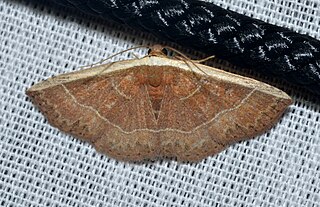
Oruza is a genus of moths of the family Erebidae erected by Francis Walker in 1862.
Radara is a genus of moths of the family Erebidae. The genus was erected by Francis Walker in 1862.

Elvia glaucata is the only species in the monotypic moth genus Elvia of the family Geometridae. It is found in New Zealand. Both the genus and the species were first described by Francis Walker in 1862.

Mellilla is a monotypic moth genus in the family Geometridae erected by Augustus Radcliffe Grote in 1873. Its only species, Mellilla xanthometata, the orangewing moth, was first described by Francis Walker in 1862. It is found in most of eastern North America.
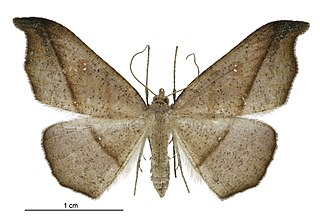
Sarisa is a monotypic moth genus in the family Geometridae and was first described by David Stephen Fletcher in 1979. The genus contains only one species, Sarisa muriferata, the hook-tip fern looper, which is endemic to New Zealand and surrounding islands. This species was described by Francis Walker in 1862. It is widespread in the North and South Islands, and has been recorded from Stewart Island, Big South Cape Island, the Chatham Islands and the Auckland Islands.
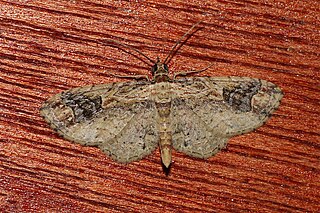
Ziridava is a genus of moths in the family Geometridae.

Auzata is a genus of moths belonging to the subfamily Drepaninae. It was erected by Walker in 1863.
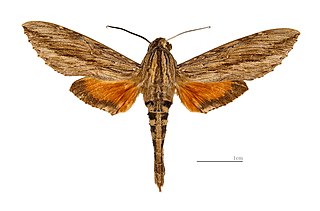
Dilophonotini is a tribe of moths of the family Sphingidae described by Hermann Burmeister in 1878.
Blavia caliginosa is a moth of the subfamily Arctiinae first described by Francis Walker in 1862. It is found on Borneo.

Blavia scoteola is a moth of the subfamily Arctiinae first described by George Hampson in 1900. It is found in the Indian state of Sikkim and Taiwan.













